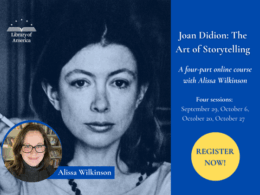In his new book, Bob Dylan in America, Sean Wilentz opens his chapter on “The Beat Generation and Allen Ginsberg’s America” by noting the impact the Aaron Copland–scored movie of John Steinbeck’s Of Mice and Men had on eighteen-year-old Jack Kerouac in 1940. Nearly two decades after catching the movie at a midnight show, Kerouac recaptured the experience in “54th Chorus,” a poem he included in Mexico City Blues.
Fast forward another twenty years and Kerouac’s Beat doppelganger Allen Ginsberg is filmed reciting “54th Chorus” when he and Bob Dylan visit Kerouac’s grave in Lowell, Massachusetts:
[Ginsberg invoked] specters, fatigue, mortality, Mexico, and John Steinbeck’s boxcar America, while he and Dylan contemplated Kerouac’s headstone. And when Dylan included footage of the event in the film he made in and about the Rolling Thunder tour, yet another complicated cultural circuit closed, linking Kerouac listening to Copland and watching Steinbeck’s Of Mice and Men in 1940 with the scene at Kerouac’s grave in Renaldo and Clara in 1977.
Dylan never met Kerouac (who died forty-one years ago today). But he loved Kerouac’s “breathless, dynamic, bop phrases.” Wilentz details the close and complex relationship between the folk-music crowd and the Beats in Greenwich Village in the 1950s and 1960s. Dylan arrived there in January 1961, having read the Beats in Minneapolis:
I came out of the wildness and just naturally fell in with the Beat scene, the bohemian, Be Bop crowd, it was pretty much connected, “ Dylan said in 1985. “It was Jack Kerouac, Ginsberg, Corso, Felinghetti . . . I got in at the tail end of that and it was magic. . . . it had just as big an impact on me as Elvis Presley.
But while Dylan could identify with Kerouac as another “young man from a small industrial town who had come to New York as a cultural outsider,” the friendship he developed with Ginsberg transformed both their lives. They first met at a party thrown by Wilentz’s uncle in December 1963 and their bond deepened over decades, “each influencing the other,” as Wilentz writes, “while their admirers forged the counterculture that profoundly affected American life at the end of the twentieth century.”
A recent post by John Dorsey about On the Road reminds us that twenty-first century writers are discovering Kerouac afresh:
What I had failed to realize before this moment is that things have never been innocent, they’ve never been easy, you just couldn’t Tweet about them. So what makes Kerouac vital today? In these turbulent times he offers a sense of stability, the knowledge that what you are feeling is normal, that we all have fears, no matter how different they may be. You are the Kerouac of future generations, so is the guy sitting next to you in the food court; you just have to be willing to travel, even if it’s only in your mind, and be willing to unpack your sense of adventure.
And in an interview about the new film adaptation of On the Road by Walter Salles and Jose Rivera (director and screenwriter respectively of The Motorcycle Diaries), Kristen Stewart, who plays Marylou, revealed that On the Road was “her first favorite book” when she read it at fourteen. Due to be released in 2011, the film stars Sam Riley as Sal Paradise, Garrett Hedlund as Dean Moriarty, and also features Kirsten Dunst, Viggo Mortensen, Amy Adams, Steve Buscemi, and Terrence Howard.



